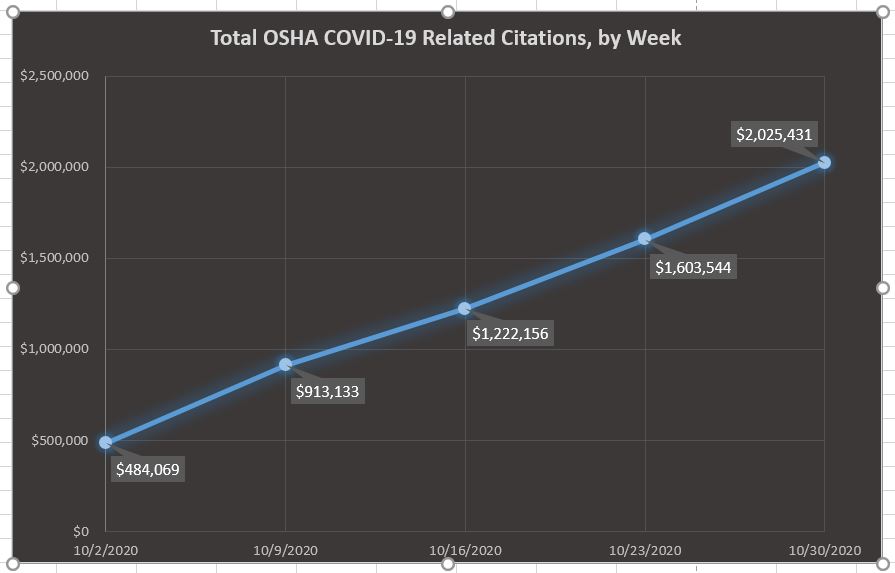Article courtesy of Clark Insurance
Confirmed cases of COVID-19 have now been found in nearly all parts of the country, and outbreaks among workers in industries other than healthcare, emergency response, or correctional institutions have been identified. As transmission and prevention of infection have become better understood, both the government and the private sector have taken rapid and evolving steps to slow the virus’s spread, protect employees, and adapt to new ways of doing business.
The COVID-19 pandemic has required businesses across a wide-range of industries to rethink how to best protect their employees, customers, and other stakeholders during continued business operations. As the occupational landscape continues to evolve, the U.S. Occupational Safety and Health Administration (OSHA) has taken in increasing role in responding to complaints and investigating instances of COVID-19 related workplace hazards. In this article, we will review how OSHA has responded to the pandemic, and explore what you can do to keep your business and your employees safe.
As of October 28th, 2020 state and federal OSHA have responded to over 40,000 complaints and over 5,000 referrals related to COVID-19 exposure in the workplace, resulting in more than 4,500 workplace inspections. In its most recent new release on October 30th, 2020, OSHA states that it has issued COVID-19 related violations totaling $2,025,431 in proposed penalties.

Source: https://www.osha.gov/news/newsreleases/infodate-m/202010
Much of OSHA’s recent enforcement activity has targeted essential industries where employees may be at increased risk of contracting COVID-19, including: healthcare occupations; retail establishments; grocery stores; construction; meatpacking and processing; warehousing; restaurants and lodging establishments; and automotive repair. OSHA estimates that these activities have mitigated exposure to COVID-19 hazards for over 643,000 workers.
As with any workplace hazard, an OSHA inspection could be triggered by several events, such as: a planned inspection; referral from another agency or source; following an employee complaint, or in the event of a death or serious injury.
The absence of a federal emergency standard for COVID-19 workplace safety has not prevented OSHA from issuing citations under existing regulations, including:
- Respiratory Protection standard (29 CFR 1910.134), which requires employers to provide adequate protection to employees exposed to respiratory hazards.
- Personal Protective Equipment (PPE) standards (29 CFR 1910.132) which requires employers to provide adequate protective clothing (such as eye, face, hand, and body protection) to protect against hazards present in the workplace.
- Injury Recording and Recordkeeping standards (29 CFR 1904) requiring employers to adequately record and report injuries, illnesses, and fatalities.
- The General Duty Clause (Section 5(a)(1) of the OSH Act) which requires employers to provide a workplace free of recognized hazards likely to cause death or serious physical harm.
As an employer, you likely have the desire to provide your employees with a safe and healthy work environment. Making good faith efforts and implementing effective procedures will help to ensure that your employees and your business are protected as well as mitigate any potential OSHA impact. You should follow the recommendations issued by OSHA, the U.S. Centers for Disease Control (CDC), and state and local jurisdictions. Consider whether you have:
- Implemented methods for employee screening or self-certification before reporting to work.
- Provided the appropriate PPE for your employees, including the use of face coverings
- Established physical barriers, optimized workspace layout, or limited capacity to allow for adequate social distancing.
- Leveraged technology to minimize the occurrence of face-to-face meetings.
- Established regular cleaning and sanitization protocols of high touch surfaces, tools, and equipment.
- Developed a plan to respond to a confirmed or suspected case of COVID-19 in your workplace. Should a case of COVID-19 occur, it is also important to know how to evaluate whether it is work related, and in what circumstances a case must be reported to OSHA.
Sources:
https://www.osha.gov/news/newsreleases/national/10302020
https://www.osha.gov/enforcement/covid-19-data
https://www.osha.gov/SLTC/covid-19/covid-19-faq.html#reporting
Original article can be accessed here: https://conta.cc/2TMwS1y
